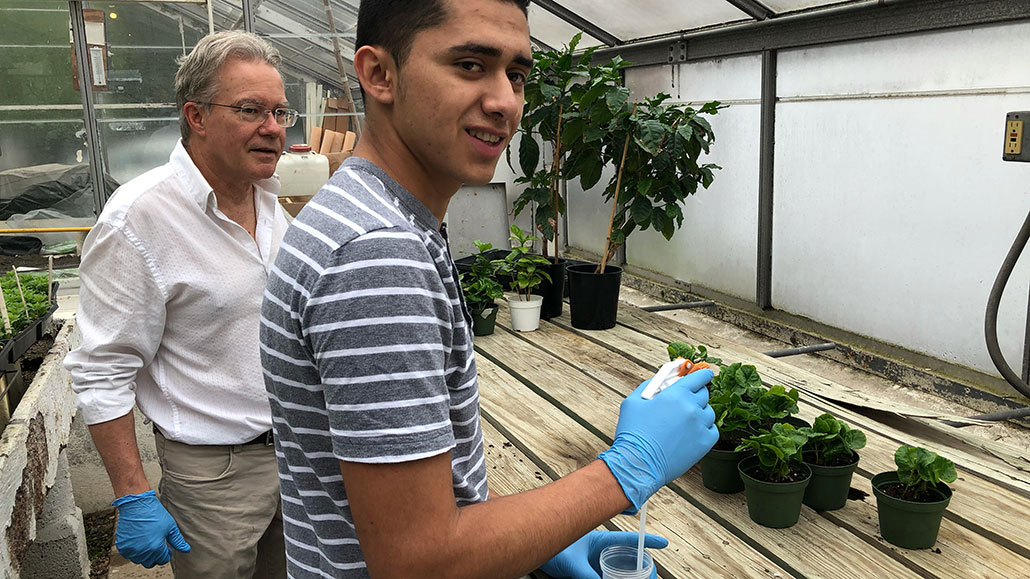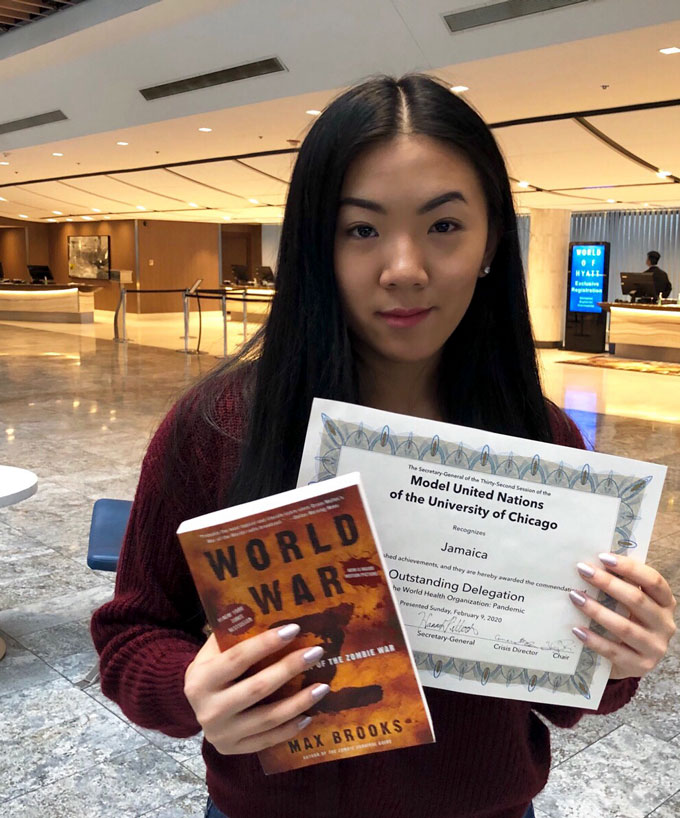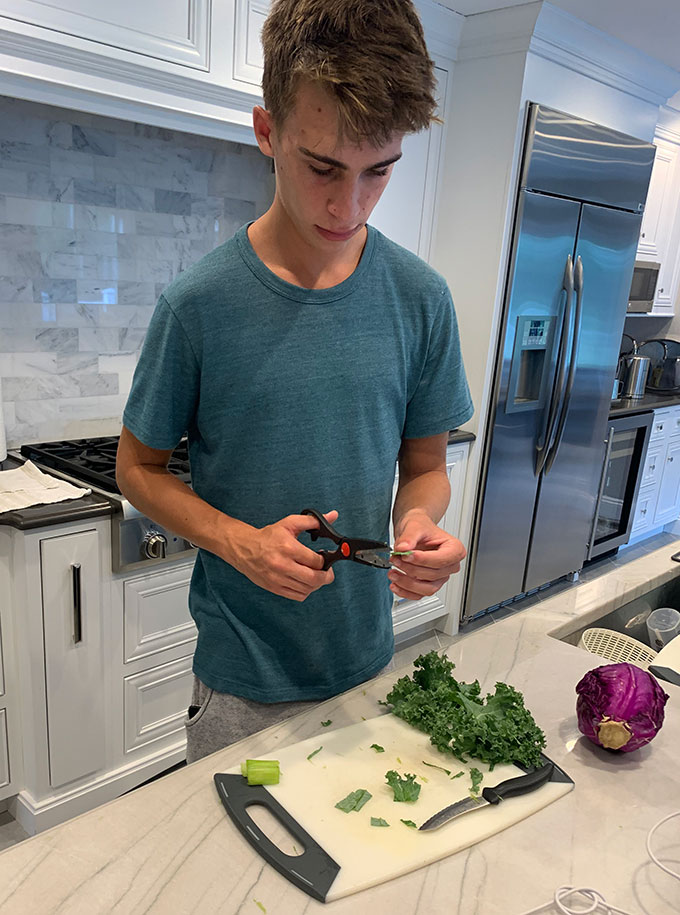When COVID-19 comes for your science fair
The pandemic brought the world to a halt — but science fair research went on

Edgar Sosa (center) works with his mentor Wade Elmer in a greenhouse. Edgar treated coffee plants with metal particles to protect them from a deadly fungus.
E. Sosa
School is not like it used to be. With the COVID-19 pandemic, classes moved online for many students. Others spent class time in socially distanced bubbles. Subjects like history became more difficult than usual, and band and sports even more so. What about projects for the science fair? This year, finalists in the Regeneron Science Talent Search faced labs shutting down, jobs drying up and research grinding to a halt.
But they didn’t let a pandemic stop them.
Some students took their work in new directions, switching projects or jobs. Others switched their focus to COVID-19 itself. And a few even built their own labs, taking advantage of space in the garage or a spare bathroom.
The Regeneron Science Talent Search (STS) brings together 40 high school seniors from across the United States. This week they compete for more than $1.8 million in awards. STS was created by the Society for Science, which still runs the program and also publishes Science News for Students.
New world, new work
Edgar Sosa, 20, had finished most of his project by the time the pandemic hit. The senior at Greenwich High School in Connecticut was trying to find a way to stop coffee rust — a fungus that attacks coffee plants.
“I love plants,” Edgar says. “I’ve been surrounded by plants since I was born.” His family had owned a coffee farm in Guatemala, but coffee rust attacked the plants. Edgar eventually moved to the United States. Before the pandemic, he completed a research project that showed spraying coffee plants with tiny copper particles could help protect them against a fungus. It might even guard them against coffee rust.
But by the time COVID-19 hit, the more pressing problem was his job as a waiter. “I’ve been working almost every day since I came [to the United States],” Edgar says. The pandemic kept people from going to restaurants. So Edgar had to find another job. He spent the summer landscaping and helping to install pools. During this time, his research stopped. “I got stuck and couldn’t keep moving forward,” he says. Once he can get back to the greenhouse, though, he hopes to continue his research. “There’s always a new day.”
For Michael Gomez, 17, a school shutdown meant a lab shutdown. A senior at Bergen County Academies in Hackensack, N.J., Gomez was studying how a drug called celecoxib (Seh-leh-COX-ib) might change melanin — a pigment that gives skin its color. By using the drug to change how much melanin skin cells produce, Michael hopes to help people who suffer scarring from injuries or acne.
“The lab I used was in school,” he says. “I would go during lunch. [Then] my school shut down so I couldn’t continue the wet lab aspect.” He turned to the internet. He used a database to see if genes for melanin — DNA instructions for making proteins — changed in response to his drug. But he can’t confirm his findings, at least not yet. Without lab experiments, “I wasn’t able to fully establish it,” he explains.
Pandemic science

For Vivian Yee, 17, COVID-19 didn’t affect her project. COVID-19 was her project.
The senior at International Academy in Bloomfield Hills, Mich., was horrified to see how the pandemic was impacting some groups of people more than others. She was especially interested in how social factors such as race, poverty and education might affect the spread of COVID-19 and efforts to fight the disease. These social factors are also known as social vulnerabilities.
As she read studies early in the pandemic, the senior saw something missing. “I saw that when looking at social vulnerability, they were only accounting for like one or two different factors,” she says. But there are 15 different social factors that could affect disease spread.
Vivian completed a virtual summer internship with Asad Moten, a scientist at the U.S. Department of Defense. She looked at all 15 social factors and showed that communities with less education and healthcare had suffered more from COVID-19.
The senior then came up with ideas for how to help communities most at risk from COVID-19. Her mentor sent her ideas to his member of Congress. The ideas got included in a memo presented to the federal government’s Coronavirus Task Force. She is also working on publishing her results in a scientific journal.
For Vivian, this kind of research was entirely new. “I was always in the laboratory, growing cells,” she says. “I definitely, this summer, learned through a lot of trial and error.”
Home is where the lab is
Sometimes, when you can’t go to the lab, you can bring the lab home. That’s what Jared Ilan, 17, and Parisa Vaziri, 18, did.
Parisa, a senior at Plano East Senior High School in Plano, Texas, had been studying fruit flies. She worked in a lab at the University of California, Berkeley in the summer of 2019. But the next year, that wasn’t possible. So the UC Berkeley lab mailed her boxes of fruit flies, and Parisa cleared out her bathroom. “I had to make a deal with my mom that none [of the flies] would escape,” she says. The teen set up shelves in her shower to store flies, and put a microscope over the toilet. She posted about her new mini lab on TikTok, where the video has received almost 300,000 likes and thousands of comments.
The teen was studying how two genes might affect symptoms of Parkinson’s disease. This disorder occurs most often in older people and affects their movement. Parisa carefully bred and tested fruit flies to see how well they could fly and climb. She also teased apart their brain cells with a needle to study them. “I was in there 10 hours a day,” she says. COVID-19 has been terrible, she notes, but “I’m grateful that it brought me a lot of unique experiences.”

Jared, a senior at Byram Hills High School in Armonk, N.Y., was trying to figure out how to grow meat from animal cells in a dish. Animal cells need structures to grow on. Usually those are provided by our bodies. To grow meat without a whole cow or chicken, Jared was looking to use plant structures. “Initially I was going to do it in the lab, growing meat on plants,” he says. “I had to do it in the garage instead.”
He built a device to test how meat cells stretched in comparison to celery, kale and cabbage. He wanted to find out which plant cells might best support a growing laboratory burger. Celery won out.
COVID-19 has been hard. Many of this year’s STS finalists had to change projects and learn entirely new things. But that’s not always bad. The pandemic, Jared says, “taught me to improvise. I think even though I wasn’t able to do things in a lab, I ended up getting results that could be significant in my field.”
Mathematical matchmaker wins big prize
On the evening of March 17, Yunseo Choi won the top prize of $250,000 in the Regeneron Science Talent Search 2021 competition. Each year, 40 high school seniors from across the United States face judges and share their scientific projects and test their problem-solving abilities. This year, finalists shared more than $1.8 million in prizes.
Yunseo, 18, is a senior at Phillips Exeter Academy in Exeter, N.H. She applied mathematical principles to determine how to match pairs of items in conditions where the total items are infinite. This kind of matching math is used every day, from helping to match patients with organ donors to matching people on dating apps. She refers to it as getting to play a mathematical matchmaker in her own version of The Bachelor.
Noah Getz, 17, came in second place and won a prize of $175,000. When COVID-19 shut down the lab he was working in, the senior at the Bronx High School of Science in New York City shifted his project to the computer. He used a model to predict small drug compounds that could reduce inflammation in Alzheimers’ disease and COVID-19. Eshani Jha, 17, came in third place and will take home $150,000. The senior at Lynbrook High School in San Jose, Calif., developed a water filter that can remove heavy metals, drugs, microplastics and more from water. Her design is patent-pending, and she has started her own company to develop it. Seven more high school seniors took home between $40,000 and $100,000. Another 30 finalists each received $25,000.







